Carnets de Géologie / Notebooks on Geology: Book 2009/03, Chapter 7 (CG2009_B03/07)
N., P.J. & P. (2009).- Paleontological parks and museums and prominent fossil sites in Thailand and their importance in the conservation of fossils.- In: J.H. & B.R.C. (eds.), PaleoParks - The protection and conservation of fossil sites worldwide.- Carnets de Géologie / Notebooks on Geology, Brest, Book 2009/03, Chapter 07 (CG2009_B03/07)
Many important fossils have been recently discovered in Thailand and serve as important keys for learning about the diversity and evolution of life through time. However, some fossils have been lost to private collectors both in Thailand and overseas. To protect these natural heritages, paleontological parks and museums have been established through the joint efforts of many organizations: the Department of Mineral Resources, universities, public enterprises, local administrative governments, and private companies. The result of the collaboration has been the establishment of the Museum of the Lignite Study Center (Mae Moh) and Petrified Forest Park in northern Thailand, Phuwiang National Park, Phuwiang Dinosaur Museum, Phu Kum Khao Dinosaur Research Center, Phu Kum Khao Dinosaur Site Museum, and the Museum of Petrified Wood and Mineral Resources in northeastern Thailand, and the Fossil Shell Cemetery in southern Thailand. In addition, the Geological Museum and national Geological Museum were established in central Thailand. All of these paleontological parks and museums, plus several local museums, play very important roles in fossil conservation. The goals are not only to preserve the fossils in collections but also to educate the public about the values of fossils, to instill a desire to protect these valuable national resources, and to act as centers for international collaboration in research and conservation.
Paleontological park; museum; Thailand; fossils; petrified wood; dinosaurs.
Les parcs et musées paléontologiques et les principaux gisements fossilifères de Thaïlande : leur rôle dans la sauvegarde des fossiles.- De nombreux gîtes fossilifères importants récemment découverts en Thaïlande fournissent des données essentielles pour comprendre la biodiversité passée et l'évolution de la vie au cours du temps. Nous devons cependant déplorer le fait que certains fossiles soient perdus ou détenus par des collectionneurs privés, tant en Thaïlande qu'à l'étranger. Afin de protéger cet héritage naturel, des musées et parcs paléontologiques régionaux ont été créés grâce aux efforts de plusieurs organisations : le Département des Ressources Minérales, les Universités, les administrations gouvernementales locales, les entreprises publiques et plusieurs compagnies privées. Cette collaboration a permis la création du Centre d'étude de la lignite de Mae Moh et du Parc de la forêt pétrifiée, dans le Nord de la Thaïlande ; le Parc national et le Musée des dinosaures de Phuwiang, le centre de recherche et le musée des dinosaures de Phu Kum Khao ; le Musée des ressources minérales et bois pétrifiés dans le Nord-Est de la Thaïlande et, enfin, dans le Sud de la Thaïlande le Cimetière de coquilles fossiles. De plus, un Musée géologique et un Musée national de géologie ont été créés dans le centre de la Thaïlande. Tous ces musées et parcs paléontologiques, ainsi que plusieurs musées locaux, jouent un rôle essentiel dans la conservation des fossiles. Le but n'est pas seulement de préserver les fossiles en collections, mais également d'éduquer le public et de le sensibiliser à l'importance de la préservation et de la mise en valeur de ces ressources nationales. Enfin, ces institutions jouent un rôle fondamental dans les collaborations internationales, aussi bien en terme de recherches scientifiques que de conservation.
Parc paléontologique ; musée ; Thaïlande ; fossiles ; bois fossiles ; dinosaures.
Numerous fossils have been discovered in Thailand over the past fifty years, and especially during the last decade. Some of the earliest reports of fossils in Thailand were on fish from the North in 1916 and on trilobites from the Carboniferous Period in Phatthalung Province in the South in 1920 (Department of Mineral Resources (DMR),
1969; , 2002). The known fossil record in Thailand ranges from Cambrian trilobites up to Holocene pollen. Although these fossils are considered part of the national heritage, many of them face multitudinous threats. Numerous fossils have been damaged and the sites destroyed during the process of mining lignite, sand, limestone, and other economically important rocks. Additional fossils have ended up in private collections both locally and overseas. Some of the fossils have been used to make jewelry and other items. To protect these fossils and fossil sites and to increase awareness of fossils in the public, the Department of Mineral Resources (DMR) with the collaboration of other organizations, such as the National Park, Wildlife and Plant Conservation Department, universities, local governments, public enterprises, and some private enterprises, have set up paleontological parks and museums in Thailand. In this paper, after a brief overview of the fossil record in Thailand, we will describe paleoparks, museums, and some prominent fossil sites
(Fig. 1 ![]() ), examine their importance for paleontology and conservation, and discuss what the future may hold.
), examine their importance for paleontology and conservation, and discuss what the future may hold.
Thailand is located in the center of the Southeast Asian mainland, from 5°37' - 20°27' N latitude and from 97°22' - 105°37' E longitude. The total area is 514,000 km². The local climate is tropical and characterized by monsoons. Thailand shares its border with Myanmar in the west and north, Laos in the northeast, Cambodia in the east, and Malaysia in the south. Thailand is mountainous in the north and west resulting from the uplift of Precambrian to Mesozoic rocks. The central plains overlie Cenozoic deposits. East of the plains are hills often capped with Jurassic sandstone. Northeastern Thailand comprises the Khorat Plateau, underlain by Jurassic-Cretaceous rocks. The east consists of plains and hills underlain by Precambrian to Mesozoic rocks. In Southern Thailand lie a series of longitudinal mountain ranges, formed from Paleozoic-Mesozoic sedimentary rocks and Mesozoic granites (, 1997).
The oldest records of ancient life in Thailand are trilobite fossils from the Cambrian Period. The fossils were found in the Tarutao Formation (about 500 million years ago) on Tarutao Island, Satun Province, southern Thailand. Fossil records from the Ordovician Period in Thailand are few, but include nautiloids, other mollusks, and trilobites from Kanchanaburi Province in the West and Satun and Nakhon Si Thammarat provinces in the South. From the Silurian Period, fossils were discovered in the Northeast and North of Thailand, including corals and mollusks from Loei Province and graptolites from Chiang Mai Province. Fossils from the Devonian Period are mostly invertebrate marine animals, such as corals and stromatoporoids from Loei Province, trilobites from Satun, and graptolites from Chiang Mai. Vertebrate remains of shark teeth have also been recovered from Mae Hong Son Province in the North (DMR, 2006).
The oldest confirmed records of plant macrofossils in Thailand are from the Carboniferous Period. Carboniferous plants include lepidophytes, sphenophytes, pteridospermophytes, and cordaitophytes from Loei Province ( et alii, 2003). However, most fossils from this period are from animals, especially marine invertebrates, such as ammonites, trilobites, corals, and mollusks, distributed in all regions of Thailand (DMR, 2006).
Permian fossils of Thailand are mostly found in limestone scattered in many parts of Thailand. A variety of invertebrate marine animals, including sponges, bryozoans, corals, brachiopods, bivalves, ammonites, trilobites, and ostracodes, plus fusulinids have been found (DMR, 2006). Permian plants are uncommon in Thailand, but plant fossils, including sphenophytes, pteridosperms, cycadaleans, and cordaitaleans, have been found in Petchabun Province in Central Thailand and in Loei Province in the Northeast (, 1966, 1968). Petrified wood assigned to Dadoxylon (Coniferales) and wood with possible affinity to Ginkgo were found in Petchabun Province (, 2006).
Fossils from the Triassic Period are invertebrate marine animals and protists, such as bivalves and ammonites from Lampang Province and foraminifera, radiolarians, and conodonts in limestone along the western edge of Thailand from Mae Hong Son in the North to Songkhla Province in the South. The vertebrate remains of ichthyosaurs have been found from Phatthalung, southern Thailand. The oldest dinosaur fossils of Thailand, dating back to the Late Triassic, are prosauropods from Phetchabun Province and the sauropod Isanosaurus attavipachi from Chaiyaphum Province. Other vertebrate fossils are amphibians, fresh water crocodiles, bony fishes, sharks, and turtles from Khon Kaen and Chaiyaphum provinces in the Northeast (DMR, 2006).
From the Jurassic, a greater diversity of fossils, both marine and terrestrial, have been found. The discovery of marine fossils along the western side of Thailand, such as ammonites, bivalves, and corals in Tak Province in the North and Chumphon Province in the South, indicate that the land in the western zone of Thailand was separated from the rest of Thailand by a narrow sea at that time. Terrestrial and freshwater deposits have yielded fossils of insects, conchostraceans, and dinosaurs from Krabi Province and oysters, freshwater hybodont sharks, semionotiform fish, lungfish, temnospondyl amphibians, turtles, and crocodiles from Nakhon Si Thammarat Province in the South ( et alii, 2006). In the Northeast, vertebrate fossils include a lungfish, hybodont sharks, a temnospondyl amphibian, a fresh water crocodile, carnivorous and herbivorous dinosaurs, and a giant turtle ( et alii, 2003; et alii, 2003; DMR, 2006). Numerous Lepidotes fish have been found at Phu Nam Jun site, Kalasin Province ( et alii, 2004).
Most dinosaur remains in Thailand, which range from the Late Triassic to the mid Cretaceous, have been found in the Khorat Plateau in the Northeast, including the Jurassic dinosaurs mentioned above and numerous specimens from the Early Cretaceous. Siamotyrannus isanensis, Phuwiangosaurus sirindhornae, Siamosaurus suteethorni, and Psittacosaurus sattayaraki are all new species of dinosaurs from the Early Cretaceous ( et alii, 2003a). Besides dinosaur bones and teeth, many dinosaur footprints are found in Khon Kaen, Loei, Prachinburi, Kalasin, Nong Bua Lamphu, and Nakhon Phanom provinces (DMR, 2006). A recent fascinating discovery is that of very small dinosaur eggs, possibly of theropods, including one with the remains of an embryo ( et alii, 2003a, 2005). Other vertebrate fossils from the Early Cretaceous of the Northeast include the remains of freshwater sharks, actinopterygian fish, turtles, crocodiles, and the tooth of a pterodactyloid pterosaur ( et alii, 2003b).
Mesozoic plants are not especially common in Thailand, although silicified wood is abundant in some areas of the Northeast. From the Late Triassic of the Northeast are fossils of Sphenophyta, Pteridophyta, Cycadales, Bennettitales, and Coniferales ( et alii, 1981). Silicified conifer wood has been found in Jurassic and Early Cretaceous deposits in the Northeast ( et alii, 2004). Fossils of Pteridophyta, Benettitales, and Coniferales, including a rare occurrence of amber, have been reported from Jurassic sites in Trang and Krabi provinces in the South ( et alii, 1981; et alii, 2006).
A series of Paleogene – Neogene basins extend from Northern to Southern Thailand. The Krabi Basin in the South, considered to be Late Eocene based on vertebrate fossils, has yielded many fossils, including approximately 6 reptile species: snakes, crocodiles, and turtles, and 27 species of mammals: primates, artiodactyls, perrissodactyls (DMR, 2001). A thick deposit of shells, predominantly of gastropods, also occurs. In addition, plant macrofossils and pollen were collected ( et alii, 1999) from the basin.
The basins in Northern Thailand include Mae Moh, Mae Tip, Pong, Chiang Muan, Lampang, Li, and Mae Sod basins. About 43 mammalian species, including a primate, carnivores, artiodactyls, bats, tree shrews, rodents, and proboscideans, have been recovered (DMR, 2001). Reptiles and mollusks also occur as fossils. Plant macrofossils, especially angiosperm leaves and conifer twigs and needles, as well pollen, have been found in some of these basins (, 1964, 1966; & , 2003; et alii, 2005a). Although the animal remains are mostly Miocene, the plant fossils range from Middle Miocene to Early Miocene or Oligocene.
In the Northeast, vertebrate fossils consist of numerous mammalian species, including about 9 proboscidean species, a primate, carnivores, hoofed mammals, and reptiles, such as crocodiles, gavials, soft-shelled turtles, and turtles. Many specimens were found in the Mun River floodplains in Nakhon Ratchasima Province ( et alii, 2004; , pers. comm., 2007).
Petrified wood from Miocene – Pleistocene deposits has been found abundantly throughout the Northeast. The wood shows a high diversity, particularly of the families Leguminosae, Dipterocarpaceae, and Combretaceae (, 2003; et alii, 2006). Leaves, wood, fruits, seeds, resin, and pollen have also been found, especially in Pleistocene deposits. A wide variety of vertebrates have been found in caves throughout Thailand, including pandas, hyenas, orangutans, and rodents, mostly from the Pleistocene and Holocene (, 1998). Numerous Holocene fossils, especially mollusks, have been recovered from Thai marine deposits ( et alii, 2003).
Among the prominent fossil sites in the North of Thailand, two places conserve and display fossils to the public: a museum in Mae Moh, Lampang Province and the Petrified Forest Park in Tak Province.
Lampang Province
Mae Moh prominent fossil site and Museum of Lignite Study Center (Mae Moh)
In Lampang, numerous and various vertebrate fossils have been found in Mae Moh lignite mine, Mae Moh District, one of the largest lignite mines in Thailand, which is owned and operated by the Electricity Generating Authority of Thailand (EGAT), a state enterprise under the Ministry of Energy. The mine, 26 kilometers from the town of Lampang, has been operated since 1955 (DMR, 2006). Geologists and paleontologists from the DMR and other researchers have come to study the fossils and geological data of the Mae Moh mine. Most fossils are found in lignite zones, aged to the Middle Miocene (about 12-13 million years ago) based upon the fossil assemblage and magnetostratigraphy ( et alii, 2002). Vertebrate fossils include fishes, snakes, turtles, soft-shelled turtles, crocodiles, and mammals. The mammals were identified as proboscideans: Stegolophodon sp., gomphotheres; rhinoceros: Gaindatherium sp.; otters: Siamogale thailandicus; and artiodactyls: Stephanocemus rucha (DMR, 2006; et alii, 2006). Among these mammalian fossils, teeth of a carnivore from the family Amphicyonidae were discovered. They were assigned to a new species, Maemohcyon potisati, thought to be related to the ancestors of bears and pandas ( et alii, 2006). Plant fossils, including wood, leaves, and pollen have also been recovered from the mine ( et alii, 2005a).
A twelve meter thick freshwater shell bed was found in 2003 deposited between two lignite layers and extending about 300 meters
(Fig. 2.A ![]() ). The shell bed was dominated by freshwater mud snails, Bellamya
(Viviparidae) (Fig. 2.B
). The shell bed was dominated by freshwater mud snails, Bellamya
(Viviparidae) (Fig. 2.B ![]() ),
with rare occurrences of tiny spiral snails, Bithynia. It may be the world's thickest freshwater shell bed. The DMR suggested that this site be conserved as a world heritage site and would like to develop it into a GeoPark ( et alii,
2005b). The Thai cabinet originally resolved that 6.88 hectares would be preserved, but later reduced the protected area to 2.88 hectares after EGAT claimed that the site would cause them to lose access to billions of dollars worth of coal. Subsequently, in March 2005, EGAT started blasting some of the site to reach the coal (Anonymous,
2005).
),
with rare occurrences of tiny spiral snails, Bithynia. It may be the world's thickest freshwater shell bed. The DMR suggested that this site be conserved as a world heritage site and would like to develop it into a GeoPark ( et alii,
2005b). The Thai cabinet originally resolved that 6.88 hectares would be preserved, but later reduced the protected area to 2.88 hectares after EGAT claimed that the site would cause them to lose access to billions of dollars worth of coal. Subsequently, in March 2005, EGAT started blasting some of the site to reach the coal (Anonymous,
2005).
In 2003, the Museum of the Lignite Study Center (Mae Moh Mine) in honor of King Prajadhipok
(Rama VII), funded by EGAT, was built next to the mine to serve as a learning center. It was opened to the public in 2005. It is divided into three zones: King Rama VII and the history of lignite, geological sciences, and operation of the mine. The geological section includes displays on paleontology and evolution of life. Visitors can learn about the origin of the earth and the evolution of life through geological time in a 3 dimensional movie theater. Most kinds of fossils from the lignite mine and some donated specimens are displayed in glass cabinets
(Fig. 2.D ![]() ), in the layers of the stratigrapic model of the lignite mine fossil site
(Fig. 2.C
), in the layers of the stratigrapic model of the lignite mine fossil site
(Fig. 2.C ![]() ).
).
Tak Province
Thailand's First Petrified Forest Park
A large petrified log, partially exposed for about 1 meter, was found by a villager in a reserve forest at Ban Tak District, Tak Province, in October 2003. The discovery of the petrified wood was reported to the National Park, Wildlife and Plant Conservation Department, under the administration of the Ministry of Natural Resources and Environment. The officer from the department subsequently came to examine the petrified log and survey the surrounding area. The petrified log was further excavated and was found to be about 4 m and 1.8 m wide at the base and the middle, respectively. The trunk was exposed to a length of 21 m without reaching the upper end
(Fig. 3.B ![]() ). Many additional pieces of petrified wood were found scattered in the surrounding area covering 35 km2 or more. Some pieces were found on the soil surface and some only partly exposed. From the survey and potentiality of the natural resources of the area, it was proposed on 29 December 2003 that a forest park be set up, covering an area of 2,000 hectares (,
2006).
). Many additional pieces of petrified wood were found scattered in the surrounding area covering 35 km2 or more. Some pieces were found on the soil surface and some only partly exposed. From the survey and potentiality of the natural resources of the area, it was proposed on 29 December 2003 that a forest park be set up, covering an area of 2,000 hectares (,
2006).
In 2004, 14 petrified wood specimens were collected and examined for preliminary identification. Most of them belonged to the family Leguminosae: Pahudioxylon sp., Afzelioxylon sp., and Peltophoroxylon sp. One specimen showed close resemblance to the living species Octomeles sumatrana (Datiscaceae) and is possibly a new taxon. Another specimen is probably a new genus of angiosperms ( et alii, 2004).
The park asked for cooperation from the DMR to use Ground Penetrating Radar (G.P. R.) to check the length of the trunk and found that 30 meters of trunk were still unexposed. In 2005, the forest park received funds to excavate the whole trunk. The result was the appearance of what is considered the world's longest piece of petrified wood, with a length of 72.22 m
(Fig. 3.C ![]() ). In 2006, the name of the park was changed to the Petrified Forest Park because of the fascinating discoveries (,
2006)
(Fig. 3.A & D
). In 2006, the name of the park was changed to the Petrified Forest Park because of the fascinating discoveries (,
2006)
(Fig. 3.A & D ![]() ). The Ministry of Natural Resources and Environment has collaborated with the DMR to examine the geological and geographical information of the area to search for more petrified wood. The silicified wood is buried in gravel, sand, and clay as part of a fluvial system. Based upon preliminary investigations, an age of approximately 800,000 years has been suggested ( & , 2006, unpublished progress report).
). The Ministry of Natural Resources and Environment has collaborated with the DMR to examine the geological and geographical information of the area to search for more petrified wood. The silicified wood is buried in gravel, sand, and clay as part of a fluvial system. Based upon preliminary investigations, an age of approximately 800,000 years has been suggested ( & , 2006, unpublished progress report).
At present, seven of nine discovered petrified trunks have been excavated, mostly in 2005, to expose the whole trunks at seven sites, with the two remaining trunks still mostly buried. The first site is where the largest petrified trunk is lying. The second to fourth trunks are cracked into many small pieces. They are 31.30 m long and 0.50 m wide, 32.40 m long and 2.10 m wide, and 44.20 m long and 1.40 m wide, respectively. The fifth trunk is 22.20 m long and 1.20 m wide, with cracks in some areas. The sixth trunk is also cracked in some parts. The actual size of this trunk was approximately 50 meters long, but the upper 20 meters were removed without permission during the digging of a water reservoir. The seventh trunk is very well preserved
(Fig. 4.A & C ![]() ). It has very large buttresses at the base and is 34 m long. The eighth trunk is very close to the seventh one in the same site, but is not completely exposed
(Fig. 4.B
). It has very large buttresses at the base and is 34 m long. The eighth trunk is very close to the seventh one in the same site, but is not completely exposed
(Fig. 4.B ![]() ), and the ninth trunk is still mostly buried in the forest. A temporary cover is being built to preserve the exposed trunks in situ. Many additional petrified trunks are still unexcavated inside the Petrified Forest Park.
), and the ninth trunk is still mostly buried in the forest. A temporary cover is being built to preserve the exposed trunks in situ. Many additional petrified trunks are still unexcavated inside the Petrified Forest Park.
Since 2004, many people, both general visitors and students, have visited the park at about 60,000 – 100,000 persons per year (, 2006). The National Park, Wildlife and Plant Conservation Department has asked a construction company to design an exhibition hall and permanent covering for the sites. Currently, the plan is in the examination process by the department. A nature trail will run between each petrified wood site so people can walk though the living forest to see marvelous stone trunks. It is expected to be a popular ecotourism spot and a place to study both ecology and paleoecology. The exhibition hall will explain the history and geology of the park, including how petrified wood occurs, its importance, and its conservation (, pers. comm., 2007).
In addition to the two sites above, numerous fossils have been collected from Northern Thailand. As mentioned previously, vertebrate, invertebrate, and plant fossils are often found in lignite mines in Cenozoic basins. Additional fossils, including Permian and Triassic, have been found in road cuts. Most of these sites, however, have not been set up as permanent parks. In 2002, Jurassic dinosaur fossils were found in Doi Phu Nang National Park, Chiang Muan District, Phayao Province. After investigation by a team of paleontologists in 2003, many of them are thought to be sauropod remains. However, some were removed for personal collection or sale. The local governments, both district and subdistrict, are trying to preserve them in situ, including developing the area to be a new tourism spot. This area may be set up as another paleontological park in the future (Faculty of Environment and Resource Studies, 2005).
Khon Kaen Province
Phuwiang National Park and Phuwiang Dinosaur Museum
Many fossils, especially Mesozoic to Cenozoic vertebrate fossils and wood, have been discovered in northeastern Thailand. Among them, the most famous and popular are dinosaur fossils. Many dinosaur remains have been found in Khon Kaen and Kalasin provinces. The first report of dinosaurs from Thailand was based on a bone discovered in 1976 by a Thai geologist and his team from the DMR, during a survey for uranium sources in Phuwiang District, Khon Kaen. The specimen was examined by French paleontologists and determined to be the distal end of a sauropod femur. In 1981, the area was surveyed under collaboration of a Thai- French team and more dinosaur remains were found
(Fig. 5.A ![]() ). This region was considered to be the first prominent dinosaur site in Southeast Asia and was established as Phuwiang National Park in 1992 (,
2002). The dinosaur fossil sites cover an area of approximately 400 km2 in the national park, which is under the administration of the National Park, Wildlife and Plant Conservation Department.
). This region was considered to be the first prominent dinosaur site in Southeast Asia and was established as Phuwiang National Park in 1992 (,
2002). The dinosaur fossil sites cover an area of approximately 400 km2 in the national park, which is under the administration of the National Park, Wildlife and Plant Conservation Department.
From the discoveries up to 1993, nine sites with dinosaur remains have been found within the park. Each of these sites has had a building constructed over it to protect the localities. Eight of the sites yielded dinosaur bones and teeth of sauropods, including juveniles, and/or theropods from the Sao Khua Formation, considered to be Early Cretaceous based on palynomorph studies of the underlying formation ( et alii, 1997; , 2002). The actual bones are displayed in situ or have been replaced with replicas. Another site (n° 8) has footprints of small ornithomimosaurs and other dinosaurs from the Early Cretaceous Phra Wihan Formation, which underlies the Sao Khua Fm. In addition, other vertebrate fossils, such as scales of the fish Lepidotes and turtle shells were found in some sites and in nearby areas. Unfortunately, the bones in some of the sites were damaged from disturbance and trespassing (site n° 4) or during the dismantling and replacing of the temporary cover over the site (n° 2), so only scraps of the bones were left at these sites (, 2002).
In 1999-2000, the DMR set up the Phuwiang Dinosaur Museum, about 3 km from the national park, with cooperation from the Tourism Authority of Thailand and the Khon Kaen provincial government, to be both a tourist spot and learning center of the province. The museum has displays on two floors about earth sciences, rocks and minerals, the discovery of dinosaurs in Thailand, why dinosaur fossils were found at Phuwiang, the geology of Phuwiang and the surrounding area, and how to conserve fossils. The exhibitions include the bones
(Fig. 5.C ![]() ) and life-sized models of Thai dinosaurs, such as Phuwiangosaurus sirindhornae, Siamosaurus suteethorni
(Fig. 5.D
) and life-sized models of Thai dinosaurs, such as Phuwiangosaurus sirindhornae, Siamosaurus suteethorni
(Fig. 5.D ![]() ), Siamotyrannus isanensis
(Fig. 5.B
), Siamotyrannus isanensis
(Fig. 5.B ![]() ), Compsognathus, Gallimimus, and Psittacosaurus. On the first floor, visitors can see how the work in the laboratory is done through glass. The museum is open free of charge to the public.
), Compsognathus, Gallimimus, and Psittacosaurus. On the first floor, visitors can see how the work in the laboratory is done through glass. The museum is open free of charge to the public.
Kalasin Province
Phu Kum Khao Dinosaur Site Museum
In 1970, dinosaur fossils from an unknown locality were collected by a monk, who mistook them for petrified wood, and kept at Wat Sakkawan, a temple located at Phu Kum Khao hill, Sahat Sakhan District, about 25 km. north of the main town of Kalasin. The area was surveyed by geologists from the DMR in 1980 and some additional information about dinosaur remains was found. In September 1994, more dinosaur bones were exposed and found by the monk, which was again reported to the DMR. The site showed a very interesting dinosaur fossil assemblage, but as it was the rainy season, the excavation was postponed and the site was closed temporarily and strictly protected (, 2002; et alii, 2003). The excavation was started in November 1994 by a Thai – French Team and over one hundred bones were discovered within a month. A temporary building was built to cover the site of about 240 square meters. The excavation continued until the end of 1995 (, 2002). The fossils were mapped and studied and found to consist of two species of sauropods and two species of carnosaurs. More than 630 dinosaur bones were eventually found and thought to comprise at least six individuals. Most of the bones were from sauropods. As at the Phuwiang sites, the site is part of the Sao Khua Formation, thought to be Early Cretaceous in age ( et alii, 1997).
Some dinosaur bones were dug out and replaced with replicas to protect the real specimens from damage, especially because of the monsoon climate. In 1996, the DMR built and set up the Phu Kum Khao Dinosaur Research Center close to the site. Dinosaur fossils, which had been stored at the temple, were moved to the laboratory for preservation and study, along with other plant and animal fossils from other localities (,
2002). In 1999, a permanent building was built to cover the site and set up as Phu Kum Khao Dinosaur Site Museum. Here visitors can see bones or replicas in their original positions in the sandstone
(Fig. 6.A & B ![]() ).
).
A new dinosaur museum at Phu Kum Khao was constructed in 2001, not far from the fossil excavation site
(Fig. 6.A & B ![]() ). However, the interior exhibitions were not built because of the limited budget. Research, training, and preparing of fossils in the laboratory were done at Phu Kum Khao Dinosaur Research Center. Many thousands of dinosaur and other vertebrate fossils, including those of fishes, turtles, proboscideans, gavials, and crocodiles, have been collected from throughout the country, especially the Northeast. Many activities, such as young paleontologist camps, have been organized. With the approval of additional budgets in 2004 and 2006, the interior exhibitions were constructed at the new museum. This new dinosaur museum
(Fig. 7
). However, the interior exhibitions were not built because of the limited budget. Research, training, and preparing of fossils in the laboratory were done at Phu Kum Khao Dinosaur Research Center. Many thousands of dinosaur and other vertebrate fossils, including those of fishes, turtles, proboscideans, gavials, and crocodiles, have been collected from throughout the country, especially the Northeast. Many activities, such as young paleontologist camps, have been organized. With the approval of additional budgets in 2004 and 2006, the interior exhibitions were constructed at the new museum. This new dinosaur museum
(Fig. 7 ![]() ) has been named "Sirindhorn Museum" in honor of Her Royal Highness Princess Maha Chakri Sirindhorn. It is the largest dinosaur museum in Thailand and is expected to open to the public in 2007. The museum consists of a large conference room for about 400 people and a large exhibition hall. The museum displays exhibits on the evolution and diversity of life through geological time, geology, the history of discovery of dinosaurs in Thailand, and many other aspects about dinosaurs
(Figs. 6.D
) has been named "Sirindhorn Museum" in honor of Her Royal Highness Princess Maha Chakri Sirindhorn. It is the largest dinosaur museum in Thailand and is expected to open to the public in 2007. The museum consists of a large conference room for about 400 people and a large exhibition hall. The museum displays exhibits on the evolution and diversity of life through geological time, geology, the history of discovery of dinosaurs in Thailand, and many other aspects about dinosaurs
(Figs. 6.D ![]() & 7.A-C
& 7.A-C ![]() ). The museum has a very large, well equipped laboratory for fossil collection, preparation, and preservation. In 2006, all fossils from the Phu Kum Khao Dinosaur Research Center were moved to the new laboratory at the Sirindhorn Museum. Many life-sized models of dinosaurs were built near the site and around the district
(Fig. 8
). The museum has a very large, well equipped laboratory for fossil collection, preparation, and preservation. In 2006, all fossils from the Phu Kum Khao Dinosaur Research Center were moved to the new laboratory at the Sirindhorn Museum. Many life-sized models of dinosaurs were built near the site and around the district
(Fig. 8 ![]() ).
).
The museum aims to be a learning center for the public, including organizing paleontological and geological training programs for teachers and students, to serve as a paleontological research center in Thailand, and to support the local people in producing and selling their local products, which is known as OTOP (One Tambon (Subdistrict) One Product).
Nakhon Ratchasima Province
Ban Saphan Hin Fossil Site
Besides Kalasin and Khon Kaen provinces, a high diversity and number of fossil plants and animals have been discovered in many districts of Nakhon Ratchasima in the Northeast. A new prominent dinosaur site of the Northeast was recently discovered in 2004 at Ban Saphan Hin, Suranaree Subdistrict
(Fig. 9.A-B ![]() ), where approximately one thousand dinosaur bones and teeth have been found
(Fig. 9.C
), where approximately one thousand dinosaur bones and teeth have been found
(Fig. 9.C ![]() ), preliminarily classified as iguanodontids, hadrosaurids, ornithomimids, dromeosaurids, tyrannosaurids, and sauropods, including Phuwiangosaurus (,
2005). Discovered together with the dinosaurs was an assemblage of other vertebrate remains, including well-preserved hybodont shark teeth (, unpublished report, 2005), fish scales, turtles, and soft-shelled turtles (
et alii, 2005), crocodile teeth, and a gavial skull. The specimens were scattered under a corn field covering an area about 1,225 m2.
), preliminarily classified as iguanodontids, hadrosaurids, ornithomimids, dromeosaurids, tyrannosaurids, and sauropods, including Phuwiangosaurus (,
2005). Discovered together with the dinosaurs was an assemblage of other vertebrate remains, including well-preserved hybodont shark teeth (, unpublished report, 2005), fish scales, turtles, and soft-shelled turtles (
et alii, 2005), crocodile teeth, and a gavial skull. The specimens were scattered under a corn field covering an area about 1,225 m2.
Museum of Petrified Wood and Mineral Resources
Abundant and very well preserved Cenozoic petrified wood has been found in Suranaree and Khok Kruat subdistricts, Mueang District, Nakhon Ratchasima Province. However, many specimens of petrified wood and animal fossils have been sold to private collectors, including to overseas buyers. To preserve these fossils, the Northeastern Research Center for Petrified Wood and Mineral Resources
(Fig. 10.A ![]() ) was first established and constructed in 1995 at Suranaree Subdistrict, Nakhon Ratchasima, by the collaboration among Nakhon Ratchasima Rajabhat University (NRRU), the provincial government, and the Department of Public Works and Town and Country Planning. From 2000 to 2002, the exhibition halls and some interior exhibitions were built with major support from the DMR. The center is now under the administration of NRRU and has received further support from the province, and is expected to formally open to the public in 2007. The site covers approximately 12.4 hectares and includes three museum buildings highlighting the dominant fossils of Nakhon Ratchasima: petrified wood
(Fig. 10.C
) was first established and constructed in 1995 at Suranaree Subdistrict, Nakhon Ratchasima, by the collaboration among Nakhon Ratchasima Rajabhat University (NRRU), the provincial government, and the Department of Public Works and Town and Country Planning. From 2000 to 2002, the exhibition halls and some interior exhibitions were built with major support from the DMR. The center is now under the administration of NRRU and has received further support from the province, and is expected to formally open to the public in 2007. The site covers approximately 12.4 hectares and includes three museum buildings highlighting the dominant fossils of Nakhon Ratchasima: petrified wood
(Fig. 10.C ![]() ), proboscideans
(Fig. 10.E-F
), proboscideans
(Fig. 10.E-F ![]() ), and dinosaurs
(Fig. 10.G
), and dinosaurs
(Fig. 10.G ![]() ), research buildings, a library, and a tourist center. The museum collections comprise over one thousand vertebrate fossils, including turtles, dinosaurs, and mammals, as well as invertebrates and plants, especially petrified wood. Several large petrified logs have been found at the site and are exhibited in situ
(Fig. 10.D
), research buildings, a library, and a tourist center. The museum collections comprise over one thousand vertebrate fossils, including turtles, dinosaurs, and mammals, as well as invertebrates and plants, especially petrified wood. Several large petrified logs have been found at the site and are exhibited in situ
(Fig. 10.D ![]() ). Small pavilions have been built over these logs. In addition, two outdoor petrified wood gardens display petrified wood from the Northeast. One of them conveys the geological and geographical information about the northeastern provinces where petrified wood was found
(Fig. 10.B
). Small pavilions have been built over these logs. In addition, two outdoor petrified wood gardens display petrified wood from the Northeast. One of them conveys the geological and geographical information about the northeastern provinces where petrified wood was found
(Fig. 10.B ![]() ).
).
In addition, small local museums have been set up near two Cenozoic fossil sites in Nakhon Ratchasima, namely, at Tha Chang and Khok Sung subdistricts, where numerous vertebrate and plant fossils have been recovered.
Tha Chang Fossil Site
Tha Chang Subdistrict, Chaloem Prakiat District, is famous for Miocene – Pleistocene mammalian sites. Fossils have been discovered since 1986 during sandpit operations
(Fig. 11.A ![]() ). This area became more well known in 1995 and especially 1997 when paleontologists came to investigate and identify fossils. Local people and fossil hunters have also come to collect fossils for business purposes. Many fossils were sold in Bangkok and some were sent overseas. To protect the fossils, some were stored and temporarily displayed at Rajabhat Institute Nakhon Ratchasima (which is now the university, NRRU). In 2004, all the specimens were moved for preservation and display at the Museum of Petrified Wood and Mineral Resources.
). This area became more well known in 1995 and especially 1997 when paleontologists came to investigate and identify fossils. Local people and fossil hunters have also come to collect fossils for business purposes. Many fossils were sold in Bangkok and some were sent overseas. To protect the fossils, some were stored and temporarily displayed at Rajabhat Institute Nakhon Ratchasima (which is now the university, NRRU). In 2004, all the specimens were moved for preservation and display at the Museum of Petrified Wood and Mineral Resources.
Thousands of mammalian fossils have been found at nine commercial sandpits at Tha Chang. Among them, nine genera of proboscideans
(Fig. 11.B ![]() )
[Gomphotherium, Prodeinotherium, Tetralophodon, Protanancus, Sinomastodon, Stegolophodon, Stegodon, Elephas ( et alii,
2003; & ,
2005) and Anacus? (, pers. comm.,
2007)], rhinoceros, giraffes, antilopes, Hipparion sp., and Merycopotamus sp. ( et alii,
2005) were found from the alluvial deposits of the sandpits near the Mun River. A new hominoid species, Khoratpithecus piriyai
(Fig. 11.C
)
[Gomphotherium, Prodeinotherium, Tetralophodon, Protanancus, Sinomastodon, Stegolophodon, Stegodon, Elephas ( et alii,
2003; & ,
2005) and Anacus? (, pers. comm.,
2007)], rhinoceros, giraffes, antilopes, Hipparion sp., and Merycopotamus sp. ( et alii,
2005) were found from the alluvial deposits of the sandpits near the Mun River. A new hominoid species, Khoratpithecus piriyai
(Fig. 11.C ![]() ) ( et alii,
2004) and a large tortoise shell about 1.5 meters long
(Fig. 11.D
) ( et alii,
2004) and a large tortoise shell about 1.5 meters long
(Fig. 11.D ![]() ) were also discovered. Besides animals, much wood and pollen has also been found at the sites. Some fossils were collected for study at the DMR, and many were collected by the Museum of Petrified Wood and Mineral Resources. The sites became flooded after mining operations were finished in some sandpits, along with the problem of sliding sand, so the fossil excavations mostly stopped in 2004. Moreover, the sediment in sandpits contains much sulfite, especially pyrite. Therefore, a park cannot be set up for keeping in situ fossils. However, a fossil elephant museum was built in the town of Chaloem Prakiat with collaboration from local governments at both the district and provincial level and the Tourist Authority of Thailand. However, because of limited support and scarcity of staff and paleontologists to work at the museum, it was not successful, and now part of the building is being used for other purposes.
) were also discovered. Besides animals, much wood and pollen has also been found at the sites. Some fossils were collected for study at the DMR, and many were collected by the Museum of Petrified Wood and Mineral Resources. The sites became flooded after mining operations were finished in some sandpits, along with the problem of sliding sand, so the fossil excavations mostly stopped in 2004. Moreover, the sediment in sandpits contains much sulfite, especially pyrite. Therefore, a park cannot be set up for keeping in situ fossils. However, a fossil elephant museum was built in the town of Chaloem Prakiat with collaboration from local governments at both the district and provincial level and the Tourist Authority of Thailand. However, because of limited support and scarcity of staff and paleontologists to work at the museum, it was not successful, and now part of the building is being used for other purposes.
Nevertheless, the Chaloem Prakiat District has proposed to set up a new Proboscidean Site Museum again on local government land provided by the Tha Chang Subdistrict Administrative Organization. The museum would be close to one of the sandpits and cover an area of about 2.56 hectares, including an area for excavating. The proposed museum building would be about 20 m X 45 m with three floors. This project is currently under the consideration of the central government.
Khok Sung Fossil Site
In March 2005, a new fossil site of Nakhon Ratchasima was discovered in Khok Sung Subdistrict, Mueang District. Numerous animal fossils were found in the area covering about 1.6 hectares of private land while digging out the sediment for making a water reservoir
(Fig. 10.F ![]() ). Many animal and plant remains were found in a layer of sand and gravel interbedded with clay about 5 m from the soil surface
(DMR, 2006). The site is now entirely flooded, precluding the collection of additional fossils.
). Many animal and plant remains were found in a layer of sand and gravel interbedded with clay about 5 m from the soil surface
(DMR, 2006). The site is now entirely flooded, precluding the collection of additional fossils.
Vertebrate fossils from the site include Stegodon, bovids, cervids, a hyena skull
(Fig. 10.E ![]() ), gavials, turtles, and soft-shelled turtles and are being studied by Thai paleontologists from the DMR and overseas collaborators. Plant fossils, including wood, fruits, seeds, leaves, amber, and pollen were also collected and are being studied at Suranaree University of Technology, Nakhon Ratchasima.
), gavials, turtles, and soft-shelled turtles and are being studied by Thai paleontologists from the DMR and overseas collaborators. Plant fossils, including wood, fruits, seeds, leaves, amber, and pollen were also collected and are being studied at Suranaree University of Technology, Nakhon Ratchasima.
Khok Sung Subdistrict Administrative Organization has built a small museum to house many of the fossils from the site
(Fig. 10.G ![]() ) with cooperation from the DMR on paleontological information of the site. Plans are ready to set up a larger museum in the future.
) with cooperation from the DMR on paleontological information of the site. Plans are ready to set up a larger museum in the future.
The first geological museum of Thailand was set up in the capital, Bangkok, at the DMR main office
(Fig. 12.A ![]() ). The museum is divided into nine sections: museum history, geological history, rocks, minerals, groundwater, mineral fuels, evolution of life, geology of Thailand, and applied geology. The section on evolution of life has displays about paleontology, including fossils of Thailand and replicas of dinosaur skeletons
(Fig. 12.B
). The museum is divided into nine sections: museum history, geological history, rocks, minerals, groundwater, mineral fuels, evolution of life, geology of Thailand, and applied geology. The section on evolution of life has displays about paleontology, including fossils of Thailand and replicas of dinosaur skeletons
(Fig. 12.B ![]() ).
).
A new larger national Geological Museum including a paleontological section was constructed in 1999 - 2001 in Pathum Thani Province, north of Bangkok. Now the interior exhibits are under construction.
's House Museum is a small private museum, which houses, nevertheless, many important specimens of animal and plant fossils from many geological ages. The museum is open to visitors and has been involved with collaboration with Thai and overseas researchers.
The Shell Fossil Cemetery, or Susan Hoi, in Thai, is located at Ban Laem Pho, Mueang District, along the Andaman Sea, about 19 km from Krabi city. The site is part of a national park under the supervision of the National Park, Wildlife and Plant Conservation Department. This site comprises a thick bed of fossils, predominantly gastropods, with three principal species, the largest being Viviparus sp. The age of the deposits is considered to be Late Eocene based on vertebrates ( et alii, 2001) or Early to Middle Miocene based on palynomorphs ( et alii, 1995). This site has been popular with tourists. However, the shell bed has been damaged by many people walking on it and by erosion from sea water. The bed should be protected as a paleopark by dividing it into three areas: a preservation area to be kept undisturbed, a conservation area with limited access, and a developed area with a walkway and information sign to be staffed by a guide. A museum was also proposed (Faculty of Environment and Resource Studies, 2005).
Controversies exist over some fossil sites, especially those on the private lands. For example, at Mae Moh mine, it was claimed that billions of dollars would be lost if all of the fossil shell beds were to be conserved because of lost access to lignite layers and eventually part of the beds were removed to reach the lignite. At Tha Chang fossil sites, fossil-containing sediments have been eroded during the mining process. Sliding of the sand caused the sediments from different layers to become mixed together, making it difficult to get accurate geological information.
In Ban Saphan Hin village, dinosaur and other vertebrate fossils were found scattered in calcareous conglomerate rock under private land. Many of the fossils were damaged from improper digging to take out the fossil-containing rocks for sale. In Tak, and especially in many provinces in the Northeast, numerous large petrified trunks were unearthed during construction and quarrying for gravel. The price of the rocks with embedded fossils increased. Fossils, including petrified wood, are in high demand, resulting in fossil hunting becoming a business.
Some local villagers in Thailand have earned their living from selling fossils for over twenty years. Paleontologists have been trying to protect fossils by explaining their importance and requesting that the villagers donate the fossils for research and refrain from selling them. However, these attempts have not always been successful as it would interfere with the earnings of the villagers or others. In fact, fossils are sometimes concealed, including covering up fossil localities, so that the fossils can be sold secretly later. To make the people understand and realize the scientific value of fossils without causing conflict, collaboration with concerned organizations, including local governments, are needed. The villagers should be helped in finding other ways to earn their living, rather than selling fossils, such as by supporting them to make products from other local renewable natural resources and providing vocational training.
Unclear laws on fossils, limited budget, and the small number of Thai paleontologists are other factors that impede fossil conservation. More precise laws on the protection of fossils in Thailand are currently being considered by the DMR.
Since Thailand is a tropical country, much of which is covered with dense vegetation, perhaps the majority of fossils are exposed or made accessible in areas of human activity, such as in mines, quarries, and road cuts. Because of the low number of paleontologists, many fossils are lost in the process of mining and quarrying. Often when mining is completed in an area, such as at the Tha Chang sandpits and in lignite mines in the Li and Krabi basins, the site becomes flooded preventing further collecting of fossils at least in the lower levels.
One of the best ways to perpetually conserve fossils is the setting up of paleontological parks and/or museums where the prominent fossil sites are found in each part of Thailand. Paleontological parks can protect not only fossils but also the sites and the surrounding areas, where visitors can learn about the fossils in their original position and about the geological structure of the area. However, if the sites are not appropriate for setting up a park, museums are another way to preserve fossils in Thailand.
Paleontology is considered a new science in Thailand that is not well known. Therefore, paleontological parks and museums have important roles as both learning and training centers
(Fig. 13.C ![]() ) for the public, including teaching about paleontology, geology, the evolution of life, paleobiodiversity, and the dominant natural resources of that area
(Fig. 13.D-G
) for the public, including teaching about paleontology, geology, the evolution of life, paleobiodiversity, and the dominant natural resources of that area
(Fig. 13.D-G ![]() ), in other words, serving as living paleontological encyclopedias of Thailand.
), in other words, serving as living paleontological encyclopedias of Thailand.
Paleontological parks and museums in Thailand have the same stated aims to not only preserve and collect fossils, but also to foster the public to realize the values of fossils and infuse in them a desire to protect these natural heritages, to encourage more young Thai paleontologists, and to serve as centers for international collaboration in research
(Fig. 13.A-B ![]() ) and conservation. A variety of activities, such as camping, meetings, workshops, and conferences, have been arranged with collaboration from public and other organizations. According to the records of visitors to these places, the increasing numbers from year to year indicate that Thai people are more interested in fossils now than in the past. The paleontological parks and museums help the general public have better understanding of why we need to conserve fossils and how to preserve fossils in the proper way.
) and conservation. A variety of activities, such as camping, meetings, workshops, and conferences, have been arranged with collaboration from public and other organizations. According to the records of visitors to these places, the increasing numbers from year to year indicate that Thai people are more interested in fossils now than in the past. The paleontological parks and museums help the general public have better understanding of why we need to conserve fossils and how to preserve fossils in the proper way.
Moreover, paleontological parks and museums set up in each part of Thailand increase income to local areas and support tourism. They help local people have more jobs in their hometown and reduce the jobless problem, including providing opportunities for villagers to make souvenirs from local products and sell them in souvenir shops of the parks and museums. Some products are applied to match with the museums, such as earthenware and handicrafts with dinosaurs or other animal patterns of the fossils found locally.
The authors would like to express sincere thanks to Mr. Kom , the head of the Petrified Forest Park, and his officers for useful information and assistance during a visit to the petrified wood sites. We would like to also thank Ms. Karapin , Ms. Thidawan , and Ms. Supratra for help with the field work. Thanks are also given to Dr. Varavudh , Mr. Suravech , and Ms. Thanasiri for information about dinosaurs, including photos. Ms. Yupa and Mr. Jaroon gave us helpful information about the sites from the North of Thailand. Mr. Yutthana Tosakul is thanked for preparing the map of paleoparks and prominent sites. Special thanks to Dr. Grégoire for providing French abstract and suggestion. Funding for a visit to the Petrified Forest Park in Tak Province was provided by Suranaree University of Technology. Finally, we would like to thank Prof. Jere for inviting us to contribute this paper.
anonymous (2005).- Egat freezes blasting for checking of exposed fossils.- Nation, Bangkok (2005-03-03, URL: http://www.nationmultimedia.com/).
K. (1966).- Permian plants from Phetchabun, Thailand and problems of floral migration from Gondwanaland.- Geology and Palaeontology of Southeast Asia, Tokyo, vol. 2, p. 197-237, Pls. 1-6.
K., J., M. & A. (1968).- Permian plants from Loei, Thailand.- Geology and Palaeontology of Southeast Asia, Tokyo, vol. 4, p. 82-99,Pls. XIV-XVIII.
K., N., C. & S. (1981).- Some younger Mesozoic plants from Trang, Southern Thailand.- Geology and Palaeontology of Southeast Asia, Tokyo, vol. 22, p. 35-47, Pl. XI.
M., Y., J.-J., V. & S. (2001).- Eocene Krabi basin (southern Thailand): paleontology and magnetostratigraphy.- Geological Society of America, Bulletin, Boulder, Colorado, vol. 113, n° 2, p. 265-273.
M., J., L.M., y., S. & J.-J. (2002).- Magnetostratigraphy of the Middle Miocene continental sedimentary sequences of the Mae Moh Basin in northern Thailand: evidence for counterclockwise block rotation.- Earth and Planetary Science Letters, Amsterdam, vol. 204, n° 3-4, p. 373-383.
P. (2003, unpublished).- Petrified wood of Northeastern Thailand and its implication on biodiversity and the ecosystem during the Cenozoic Era.- Unpublished Ph.D. thesis, Suranaree University of Technology, Thailand, 180 p.
M., J., C., A., C. & H. (2006).- A new Permian wood discovered in Central Thailand. In: 7th European Palaeobotany-Palynology Conference.- Program and Abstracts, National Museum, Prague, p. 14.
E., V., H., Y. & S. (1997).- New dinosaur discoveries in the Jurassic and Cretaceous of Northern Thailand. In: The International Conference on Stratigraphy and Tectonic Evolution of Southeast Asia and the South Pacific.- Bangkok, Thailand, 19-24 August 1997, p. 154-164.
E., V., G., S., H., J. & L. (2003a).- Dinosaurs in Thailand.- Mahasarakham University Journal, Mahasarakham, vol. 22, special issue, p. 69-82.
E., V., H., G. & L. (2003b).- A pterodactyloid tooth from the Sao Khua Formation (Early Cretaceous) of Thailand.- Mahasarakham University Journal, Mahasarakham, vol. 22, special issue, p. 92-98.
E., G., V., G., H., A., L., S., P.J., J. & J. (2005).- Minute theropod eggs and embryo from the Lower Cretaceous of Thailand and the dinosaur-bird transition.- Naturwissenschaften, Berlin, vol. 92, p. 477-482.
L., V., S., E. & H. (2003).- A new semionotid (Actinopterygii, Neopterygii) from the Late Jurassic-Early Cretaceous of Thailand.- Comptes Rendus Paleovol, Paris, vol. 2, n° 5, p. 291-297.
L., V., E., S., Lauprasert K., J., P., M., U. & H. (2004).- A new fish locality from the continental Late Jurassic-Early Cretaceous of northeastern Thailand.- Revue de Paléobiologie, Genève, vol. spécial 9, p. 161-167.
Y. (1998).- Plio-Pleistocene rodents of Thailand.- Thai Studies in Biodiversity, Bangkok, n° 3, 303 p.
Y., V., P., C., B. & . J.J. (2004).- A new orang-utan relative from the Late Miocene of Thailand.- Nature, London, vol. 427, p. 439-441.
G., V., E. & M. (2003).- Hybodont sharks from the Mesozoic Khorat Group of Thailand.- Mahasarakham University Journal, Mahasarakham, vol. 22, special issue, p. 49-68.
Department of Mineral Resources (1969).- Fossils of Thailand.- Geological Survey, Bangkok, Memoir 3, vol. 3, 41 p., Pls. 27-36.
Department of Mineral Resources (2001).- Geology of Thailand.- Department of Mineral Resources, Ministry of Natural Resources and Environment, Bangkok, 556 p. [in Thai].
Department of Mineral Resources (2006).- Biodiversity of Ancient Living Things in Thailand.- Department of Mineral Resources, Ministry of Natural Resources and Environment, Bangkok, 200 p. [in Thai].
Z. (2005, unpublished).- The new discovery of dinosaur fossils from Ban Sapan Hin and preliminary identification.- Unpublished report, Nakhon Ratchasima, 5 p.
S. (1964).- Some older Tertiary plants from Northern Thailand.- Geology and Palaeontology of Southeastern Asia, Tokyo, vol. 1, p. 113-117, Pl. X.
S. (1966).- A supplementary note on the Palaeogene Li Flora in North Thailand.- Geology and Palaeontology of Southeast Asia, Tokyo, vol. 3, p. 165-169, Pls. XXVIII-XXX.
Faculty of Environment and Resource Studies, Mahidol University (2005).- Final Report of the Master plan on fossil management (Volume 1).- Fossil management project propose to the Department of Mineral Resources, Ministry of Natural Resources and Environment, Thailand, July 2005 [in Thai].
P.J. & P. (2003).- Investigations of plant macrofossils from the Tertiary of Northern Thailand.- Mahasarakham University Journal, Mahasarakham, vol. 22, special issue, p. 100.
R., B., Y., H., H.& P. (2005).- Description of the Tha Chang Merycopotamus and its preserved condition. In: International Conference on Geology, Geotechnology and Mineral Resources of Indochina (GEOINDO 2005).- Khon Kaen (Thailand), 28-30 November 2005, p. 600-605.
K. (2006, unpublished).- Petrified Forest Park, Ban Tak District, Tak Province.- Ban Tak.- Unpublished report, 17 p.
J.-P., B. & S. (2003).- The Carboniferous flora of Northeastern Thailand.- Revue de Paléobiologie, Genève, vol. 22, n° 2, p. 761-797.
S., Y., C., P. & J.-J. (2006).- A new Amphicyonid (Mammalia, Carnivora, Amphicyonidae) from the late Middle Miocene of northern Thailand and a review of the amphicyonine record in Asia.- Journal of Asian Earth Sciences, Oxford, vol. 26, p. 519-532.
M., V., P., E., , L., G. & G. (2004).- Stratigraphical and palaeobiogeographical significance of fossil wood from the Mesozoic Khorat Group of Thailand.- Geological Magazine, Cambridge, vol. 141, n° 3, p. 319-328.
M., G., V., N., G., F., J., E., T., A. & H. (2006).- A Jurassic amber deposit in Southern Thailand.- Historical Biology, London, vol. 17, p. 1-6.
E., I., N., M.P. & R. (2003).- Mollusk associations of the northern Gulf of Thailand and Holocene analogs from the Bangkok Clay.- Mahasarakham University Journal, Mahasarakham, vol. 22, special issue, p. 191-213.
W. & M. (1999).- Palynology, age, and paleoenvironment of Krabi Basin, southern Thailand. In: B. & S.L. (eds.), Proceedings of the International Symposium on Shallow Tethys (ST) 5.- Chiang Mai, p. 426-439.
W., B., M., D.C., S. & W. (2005a).- Tertiary basin evolution in northern Thailand: a palynological point of view.- Natural History Bulletin of the Siam Society, Bangkok, vol. 53, n° 1, p. 17-32.
W., H., S., S., W., A. & S. (2005b).- Middle Miocene Molluscan Assemblages in Mae Moh Basin, Lampang Province, Northern Thailand.- ScienceAsia, Bangkok, vol. 31, p. 183-191.
V. (2002).- Dinosaurs of Thailand.- Second Printing. Department of Mineral Resources, Ministry of Natural Resources and Environment, Bangkok, 102 p. [in Thai].
V., E., H., J., L. & G. (2003).- Guidebook for Excursion at Phu Kum Khao Dinosaur Research Centre 30 October 2003.- 1st International Conference on Palaeontology of Southeast Asia (ICPSEA), Mahasarakham, 102 p.
Y., B., H., H., S. & P. (2003).- The Proboscidean fossils and their evolution from Tha Chang Sand pits, Chalerm Phrakiet District, Nakhon Ratchasima Province, Thailand.- Mahasarakham University Journal, Mahasarakham, vol. 22, special issue, p. 100.
Y. & B. (2005).- New proboscideans, Sinomastodon (Proboscidea, Mammalia) from Thailand. In: International Conference on Geology, Geotechnology and Mineral Resources of Indochina (GEOINDO 2005).- Khon Kaen (Thailand), 28-30 November 2005, p. 594-599.
H., V., J., E. & P. (2005).- The turtle fauna from the Khok Kruat Formation (Early Cretaceous) of Thailand. In: International Conference on Geology, Geotechnology and Mineral Resources of Indochina (GEOINDO 2005).- Khon Kaen (Thailand), 28-30 November 2005, p. 610-614.
Y.D., W., S., P., P. J. & N. (2006).- Recent advances in the study of Mesozoic – Cenozoic petrified wood from Thailand.- Progress in Natural Science, Beijing, vol. 16, issue 5, p. 501-506.
M., W. & D. (1995).- Age of the Susan Hoi (Shell Fossil Cemetary) Krabi Basin, southern Thailand. In: International Conference on Geology, Geotechnology and Mineral Resources of Indochina (Geo-Indo'95).- Khon Kaen (Thailand), 22-25 November 1995, p. 106-111.
D.R. (1997).- Thailand. In: E.M. & R.W. (eds.), Encyclopedia of European and Asia Regional Geology.- Chapman & Hall, London, p. 718-727.
W., Y.D., & S. (2004).- Identification results and technical report for the petrified fossil woods from the Mesozoic to Cenozoic of Thailand.- Shenyang, 27 p.
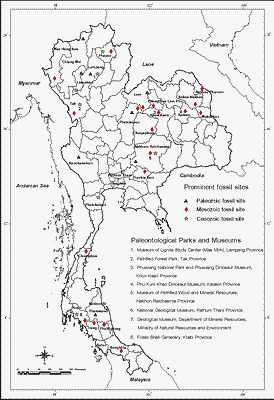
Click on thumbnail to enlarge the image.
Figure 1: Paleontological parks, museums, and major prominent fossil sites in Thailand.
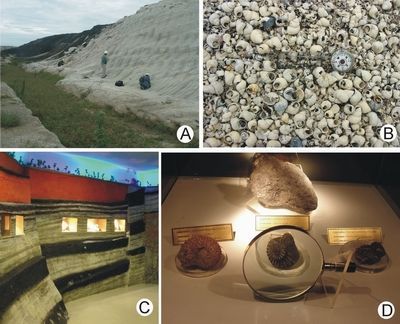
Click on thumbnail to enlarge the image.
Figure 2: Mae Moh Lignite Mine, where the world's thickest fossil shell bed was found (A). Freshwater mud snails, Bellamya (Viviparidae) (B). Stratigraphic model of lignite mine (C) in the museum with fossils shown in each glass cabinet (D). Photos courtesy of Y. and J. .
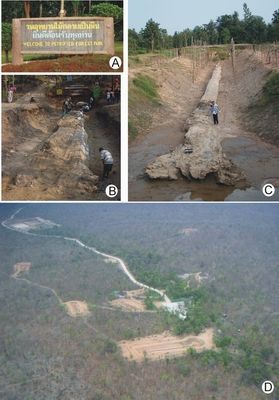
Click on thumbnail to enlarge the image.
Figure 3: Thailand's first Petrified Forest Park, Tak Province (A). The first petrified trunk partly excavated to about 21 m in length (B). The whole trunk, 72.22 m. long and probably the world's longest petrified trunk (C). Petrified wood sites in the Petrified Forest Park (D). Photo of Fig. 3.D courtesy of K. (Petrified Forest Park).
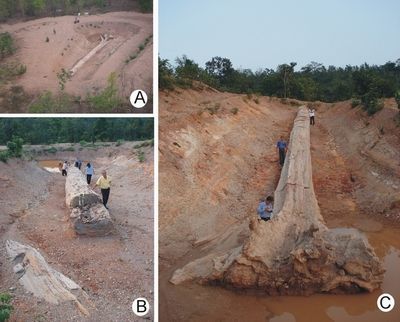
Click on thumbnail to enlarge the image.
Figure 4: Petrified wood site n° 7. Viewed from a helicopter (A). A petrified log is partially exposed next to a long petrified trunk in the same site (B). The petrified trunk of site n° 7. is about 34 m. long with very large buttresses (C). Photo of Fig. 4.A courtesy of K. (Petrified Forest Park).
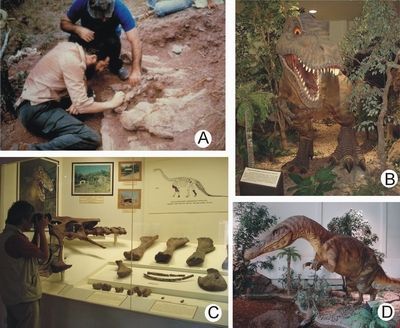
Click on thumbnail to enlarge the image.
Figure 5: Dinosaur fossils found and excavated by paleontologists in what is now Phuwiang National Park (A). A dinosaur model of Siamotyrannus isanensis (B), some dinosaur bones or replicas from Phuwiang (C), and Siamosaurus suteethorni (D) exhibited in Phuwiang Dinosaur Museum. Photo of Fig. 5.A courtesy of V. .
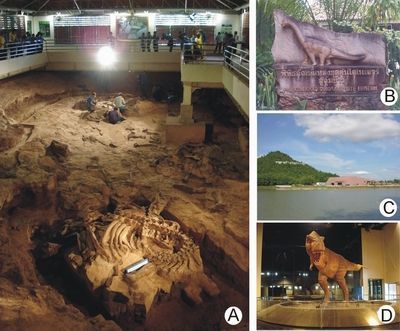
Click on thumbnail to enlarge the image.
Figure 6: Dinosaur bones found and conserved in situ (A) at Phu Kum Khao Dinosaur Site Museum (B). A new large dinosaur museum at the base of Phu Kum Khao hill (C). A dinosaur model inside the new dinosaur museum (D). Photo of Fig. 6.C courtesy of S. .
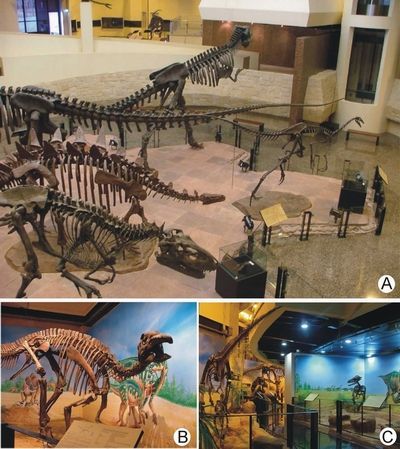
Click on thumbnail to enlarge the image.
Figure 7: Reconstructions of various dinosaur skeletons from around the world with panoramas recreating their lifestyles (A, B, and C) at Sirindhorn Dinosaur Museum. Photos courtesy of T. .
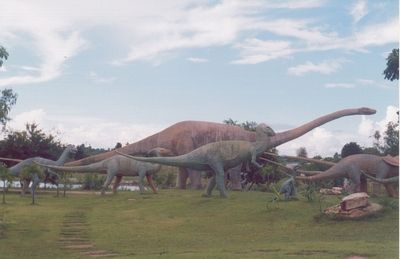
Click on thumbnail to enlarge the image.
Figure 8: Life-sized models of Thai dinosaurs built in the park, Kalasin Province.
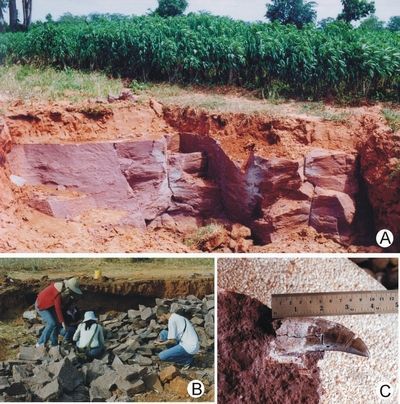
Click on thumbnail to enlarge the image.
Figure 9: Ban Saphan Hin fossil site, Nakhon Ratchasima Province (A). Calcareous conglomerate containing many dinosaur and other vertebrate fossils (B). A dinosaur tooth from the site (C).

Click on thumbnail to enlarge the image.
Figure 10: Museum of Petrified Wood and Mineral Resources (A). Petrified trunks from several provinces in the Northeast displayed in a geological garden (B). Large petrified trunks on display in petrified wood hall (C). Petrified wood conserved in situ under a pavilion (D). Proboscidean fossils from Tha Chang (E) and reconstructed skeleton (F) exhibited in proboscidean hall. Movable dinosaur models in dinosaur hall (G).
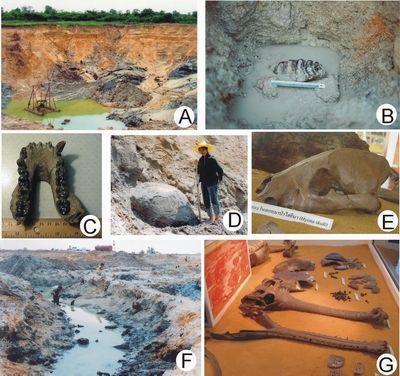
Click on thumbnail to enlarge the image.
Figure 11: One of several sandpits at Tha Chang (A), where vertebrate fossils, such as a proboscidean molar (B), jaw of a new ape species, Khoratpithecus piriyai. (C), and a giant tortoise (D) were found. A hyena skull (E) and other fossils found at Khok Sung (F). Some specimens, including a gavial skull and lower jaw (G), displayed in the local museum at Khok Sung Subdistrict. Photos of Fig. 11.E-G courtesy of J. .
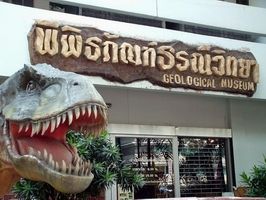 |
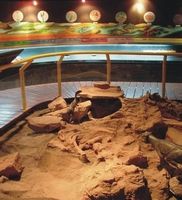 |
A |
B |
Click on thumbnail to enlarge the image.
Figure 12: Geological Museum, the Department of Mineral Resources, Bangkok (A), and fossil exhibits, including dinosaur replicas (B). Photos courtesy of S. .
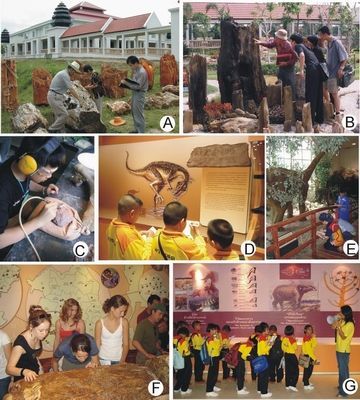
Click on thumbnail to enlarge the image.
Figure 13: Chinese paleobotanists identifying petrified wood at the Museum of Petrified Wood (A). Researchers studying fossil wood in the garden (B). A student practicing paleontological work in the laboratory of Phu Kum Khao Dinosaur Research Center (C). Children learning about Thailand's dinosaurs at the Museum of Petrified Wood (D) and Phuwiang Dinosaur Museum (E). Overseas students learning about opalized wood (F) and students studying proboscidean fossils and their evolution (G) at the Museum of Petrified Wood. Photo of Fig. 13.C courtesy of S. .